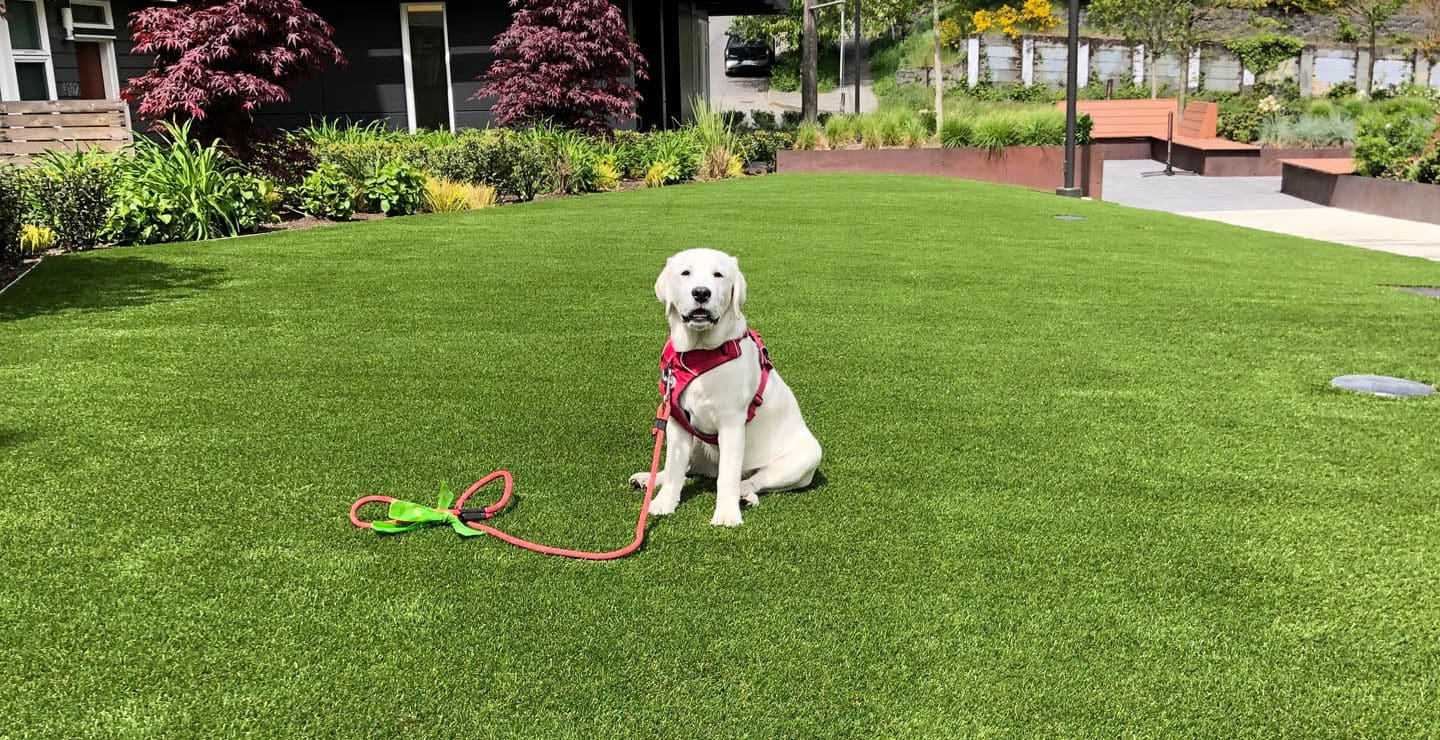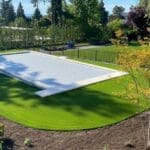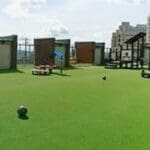When people think about getting a dog, they dream about having their dog run through the yard enjoying life and having fun. But, unfortunately, many people mistakenly assume that every backyard is perfectly safe for their dog.
The truth is that flowers, including autumn crocus and foxglove, can be hazardous for your pets. If certain flowers are consumed, they can cause your dog to have diarrhea or seizures. They can even cause death. In addition, azaleas may make your dog blind.
Several studies have been published in reputable publications that discuss the dangers dogs face from chemicals used to keep a lawn green and healthy. Exposure to these chemicals increases the chances of your animal getting bladder cancer having other problems that you would have a hard time tracking down and solving without knowing the exact cause.
Ingesting herbicides and fertilizer means medical problems for animals, the same way it does with humans. They can lead to drunkenness, halitosis, severe kidney failure, and even death, depending on the dose.
Everyone wants their lawn to look nice, but we also want our furry friends to stay healthy. You can do both. In this post, we will discuss healthy grass alternatives for dogs and the steps you can take to keep your house and the yard around it perfectly pet-friendly.
What Can I Use Instead of Grass for My Dog?
Grass, especially if it is nice and healthy, is wonderful to look at and feels great under your feet. At the same time, it requires a lot of maintenance, especially if you have a dog. If you intend on letting your dog play in your yard, you want to find dog-friendly grass alternatives that still let you enjoy your lawn.
In general, any suitable alternative should be:
- Affordable
- Almost maintenance-free
- Durable
- Easy to clean
- Not susceptible to temperature changes
- Organic feeling
- Safe for dogs to urinate and defecate on
For your dog to truly enjoy your yard and your dog-friendly alternative, it must fulfill certain criteria:
Poop and Pee Friendly
Dogs are particular about where they do their business. They want something that feels comfortable and natural. This is why dogs typically use garden beds, soft grass, and mulch to answer nature’s call.
Conducive to Exploration and Exercise
Your dog will want to explore, walk around, and just have fun in your yard. This means that your grass alternative should not harm their paws, snouts, and teeth. It shouldn’t be sharp or hard and should stay relatively cool during the summer.
Dogs also like to “carve-out” paths by running along the same line constantly. Homeowners with natural grass know this all too well and have patches of bare dirt where grass can’t grow because of the too-frequent traffic.
Space to Stretch out
Just like you, your dog likes to stretch out and enjoy the sun. However, if your grass alternative gets hot, it can make this uncomfortable. Preferably, your dog will have a place outside where they can enjoy nature and still be protected from the elements.
Non-Hazardous
You want your dog to be able to enjoy themselves without running the risk of being poisoned or hurt. This means that you need to stay away from uneven surfaces, toxic materials, or surfaces that are so slick your dog has a difficult time getting its footing and possibly damages their joints.
Of course, you are going to want to enjoy your yard and landscaping as well. You likely have some requirements, including:
- Affordability
- Little maintenance
- Appealing to the eyes – something that looks nice
- Does not easily show damage
Some pet owners have come to a compromise of sorts with their dogs. For example, the front yard is dog-friendly, and the backyard has natural grass. Others have opted to have more durable, dog-friendly surfaces in areas where people traffic the most and then have nicer, softer surfaces, such as natural grass areas, that don’t get much foot traffic.
With all this being said, let’s look at some dog-friendly grass alternatives.
Popular Grass Alternatives for Dogs
Brick and Masonry
Brick is a good grass alternative, especially if you are looking to make a path or a driveway. You may consider using brick around the perimeter of your home to make a pathway.
Brick is relatively inexpensive. It is easy to install. If your dog does answer the call of nature on the brick, you can easily clean it with a water hose. Bricks are virtually maintenance-free. They are unbelievably durable. However, they do heat up under intense sunshine, they don’t feel good to run on, and simply don’t provide a vivid landscape.
Some people prefer stone over brick because bricks may buckle. If they start to buckle, just pull up the section where there is buckling and re-level them.
Silver Carpet (dymondia margaretae)
All-natural but technically not a “grass”!
Dymondia margaretae is exceptionally sturdy. It can stand up to being trampled on by adults, children, and dogs. The nice thing about this silver green-leaved ground covering is that it starts to sprout dog-friendly yellow flowers when the weather gets warm. Additionally, it grows low to the ground. Maintenance is relatively easy.
If there is an area where your dog runs a lot, it will probably look a little patchy. But this is a hardy ground covering that will do its best to stay alive.
Most dog owners will use “silver carpets” in smaller areas. For example, if you have a place with stepping stones, this would be a great option in between the stones. You will be happy, and your dog will love you for it.
Irish Moss
This is a soft, mat-like ground cover. It is hardy and versatile. It can thrive in partial sun or full sun. However, it will need to be watered as the temperature outside increases. Make no mistake – it’s much harder to maintain than regular grass if the climate isn’t ideal.
Not really as durable as pet owners would like but Irish moss is soft and not prone to overgrowing – it will only grow about one inch tall. And during the spring and summer, you will enjoy seeing tiny white flowers that bloom.
This is a great alternative to natural grass. However, you should note that moss needs water. If you are in an area where there is drought, it is not going to be the best choice. It is better for areas where there is constant rainfall.
If you are in a dryer area, for example, the southern part of California, and you want to have Irish moss for your four-legged friend, think about installing an irrigation system set to provide deeper watering but with less frequency.
Elfin Thyme (thymus serpyllum “elfin”)
This is a dog-friendly ornamental herb. It smells incredible, especially during the summer months. If you or your dog get hungry, it is entirely edible (non-toxic) although far from nutritious for non-ruminants.
Elfin thyme grows to a max of two inches tall. If you have a rock garden, it is a nice addition. Not only does it make the rock garden look nice, but it offers a soft and cool spot for your dog to lay in.
This plant is dense and hardy, but it is not made to handle high-level traffic. However, it will handle moderate animal traffic and will fare well if your dog chooses to make it a place to take a nap.
If you have an energetic dog, this might not be the right option for you. However, if you have a smaller dog that is a little bit more relaxed, elfin thyme not only is dog-friendly but also gives you the benefit of purple flowers during the summer months.
Snow-In-Summer (cerastium tomentosum)
This is a drought-tolerant ground covering. It can grow just as well in the sun as it can in partial shade.
It is a hardy plant but not suitable for larger open fields. Snow-In-Summer can stand up to the activities of even the most hyper dog. The nice thing about this ground covering is that as it grows and spreads rapidly. In fact, it grows so rapidly that you might need to do special landscaping to contain it and prevent it from growing too far.
Depending on where you live, a bonus is that this plant is deer resistant. In addition to giving your dogs a nice place to relax, it will protect the rest of your plants from frustrating deer.
Artificial Grass For Dogs
Without a doubt, the best possible option for most homeowners who have regular jobs and don’t want to spend extra energy, time, and money dealing with maintenance and pest control is fake grass designed for dogs. Synthetic turf is a wonderful option if you are sick and tired of dealing with a live lawn. Many families are choosing pet-friendly turf installation these days, and there are plenty of good reasons why it’s a trending option.
Pet turf is the definitive dog lover’s dream. They don’t have to worry about brown spots on the grass or bare patches. And dogs rarely dig into artificial grass.
Artificial grass is simple to clean after your pet uses it as a restroom. It has a smooth and level surface that makes it safe for children to play on.
An added benefit of artificial grass is that after your dog goes outside and plays, you don’t have to worry about cleaning up patches of mud or blades of grass off of your wood floor. You will want to use a deodorizer designed to absorb the odor of pet urine.
Synthetic Turf Northwest offers an anti-microbial turf that solves this problem before it even arises so you don’t have to worry about odors.
If you are concerned about aesthetics, pet turf does not look like Astroturf. It looks and feels like natural grass.
Non-Living Groundcovers That Are Dog-Friendly
Most homeowners want living groundcovers. They don’t care if they have pets that might ruin them.
Others have concluded that living groundcovers are not worth the hassle. They need to be watered, maintained, and cared for in a way that non-living options do not.
Non-living ground coverings can withstand a drought. They eliminate unnecessary digging by your pet. And they allow you to spend more time enjoying and maintaining your yard as opposed to watering and mowing the grass.
Popular non-living and low-maintenance coverings include
- Wood chips
- Artificial grass
- Mulch
- Gravel
You want to examine your situation and find the best solution to meet your needs. Many times, the best solution is a combination of ground cover options.
Some homeowners have found it best to use a hybrid option. For example, they have a lawn area with natural grass and another area with gravel and dirt. Others might use pet-friendly groundcovers for most of the yard but then have an island in the middle with a little bit of grass and flowers. When properly landscaped, the combination of living and non-living dog-friendly groundcovers can enhance the appearance of your lawn.
The following are some nonliving dog-friendly groundcovers you may want to consider, especially if you live in an area known for drought or if you just want to have a maintenance-free backyard.
Gravel
There are several factors to consider when deciding if gravel is a good option for your dog. First, many dogs like to sunbathe on gravel on sunny days.
However, if there is not enough shade around the gravel, the gravel may burn your dog’s paws or make your dog feel hot during the summer. If your yard has shade from trees or other coverings, placing gravel over large areas could be good.
Gravel does not always work well for large dogs. Because of their extra weight, they run the risk of having gravel stuck between the pads of their paws. Of course, it doesn’t always happen, but it is something that should be considered.
A great thing about gravel is that it is easy to clean up after your pet. Solid waste can be cleaned up with little hassle, and liquid will drain through the gravel to the soil underneath.
Dirt
A little dirt won’t hurt. A lot of dirt can cause headaches, though. Regardless, many homeowners have opted to use dirt as a ground covering.
Most people won’t have their entire yard be dirt. However, they may designate a set part of the yard as a dirt area for their pet.
This gives your dog a place to use the restroom, dig, and roll around without impacting the rest of your landscaping.
Woodchips or Bark
There are several pros and cons of using woodchips as dog-friendly landscaping. Woodchips are low-maintenance. They can withstand heavy traffic, and they can easily be raked into place if your dogs have created paths in them.
However, woodchips are also home to fleas. So this is something that should be noted if you want your pet to stay safe and healthy.
Wood chips could give your dog splinters, or your dog may start to eat them. Make sure that the woodchips you purchase are not dyed, and they do not have chemicals added to them.
You can use cedar woodchips because cedar naturally repels fleas. That being said, some dogs do not react well to cedar chips. They may have respiratory issues or allergies. If you are going to use cedar chips, introduce them slowly to make sure that your dog can tolerate them.
Things to Consider When Looking for a Dog-Safe Groundcover
Clearly, there are a lot of options to choose from. How can you know which groundcover is right for your situation? Here are some factors to consider.
Climate
If you opt for a natural groundcover, like grass or plants, then you need to know if it can survive in the climate where you live.
For example, if you live in an area with little rainfall, you will want something like Snow-In-Summer or buffalo grass that can withstand drought. If you go the natural route, you will also want to make sure that the plant you choose is suitable for the ecosystem where you live.
Maintenance
The ground covering recommendations we have made require little maintenance. For example, elfin thyme does not require a lot of maintenance. You have to water it from time to time, but that is about it. However, it does grow fast and will reseed.
If you don’t care for it well, it can become invasive. With that in mind, it is good for you to think about how much work will take for you to look after a ground covering. If you are short on time, look for a non-living option, like artificial grass.
Aesthetic Appeal
Aesthetics are essential. You want to be happy with the way your yard looks. You want your dog to be happy, and you want it to be fit and healthy. Of course, you don’t want an ugly garden.
Many of the live options we have recommended are attractive and produce beautiful flowers during the spring and summer. But when it comes to aesthetics, it will be a matter of your personal taste.
Cost
Cost is an important factor, and probably the reason you went looking for grass alternatives in the first place.
For example, you may want to replace your grass with artificial turf. But if you can’t afford it, you can’t do it. Or you may be able to afford the initial install, but you’re wondering if you can afford the upkeep?
Thankfully, there are many options available for pet-friendly ground coverings that are not expensive and that can keep your pet safe and comfortable. Synthetic turf maintenance is actually lower than maintaining a real lawn, believe it or not. So the switch might cost you but you save in the long run.
Final Thoughts on Making Your Yard Dog-Friendly
Most pet owners readily agree that their dogs are like family members. People are drawn to dogs because of their non-judgmental nature. Dogs love their owners unconditionally and we love them back the same way.
That being said, you want your yard to be a place where you are happy to spend time.
It does not need to be complicated to create a canine-safe place.
A few minor changes can go a long way in protecting your lawn from patches caused by pet urine and protecting your dog from toxins found in some plants and pesticides.
Whatever dog-friendly ground covering you choose, make sure you have sufficient shade and a cool spot where your dog can rest. This will prevent your dog from tearing up the yard to try to find a cooler spot.
Train your dog to relieve themselves in a predesignated area. If there is an area where they like to go to the restroom, consider adding gravel, pavers, brick, or pet turf in that area.
We believe our Pro Series Pet Turf is the best possible low-maintenance pet-freindly ground cover available today. Contact us to learn more.





